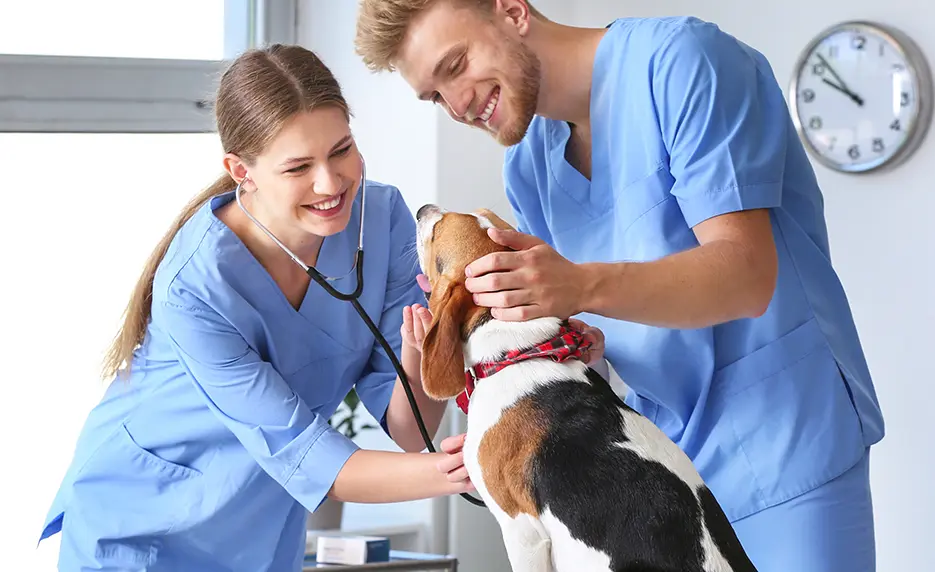PACE NONCREDIT COURSE:
Veterinary Assistant
Areas of Study
Course Type

Overview
Hours: 225 | Duration: 6 months
Do you love animals? Have you ever thought about a career as a veterinary assistant? This intensive course will provide the information you need to become a productive member of a veterinary team. The course is designed for people who want to work as veterinary assistants at veterinary hospitals and for those already employed in related positions. Upon completion of the course, you will also have the opportunity to gain access to an Externship Starter Kit.
Are you looking for veterinary assistant schools near you? The course covers all the requirements that hospitals and veterinarians’ offices look for, and more! You’ll learn about every aspect of veterinary assisting, including anatomy and physiology, animal restraint, laboratory sample collection, assisting in surgery and dentistry, prescription preparation, and taking radiographs.
You’ll also learn how to interact professionally with clients and gain the expertise you need to educate them about key topics in pet care, such as nutrition, vaccinations, and administering medication. The course concludes with a lesson to prepare you for the job market, in which you’ll see how to create an effective resume, advance your expertise, and develop strong interview skills. You will truly learn everything you need to know to be successful in your new career.
Disclaimer: To qualify for the externship applications process, students must successfully complete the online course content and have account balances up to date (at a minimum). Going through the externship application process does not guarantee an externship. COVID may be affecting the externship process or site availability in your area. Students can begin researching the steps of the application process 2 weeks prior to completing courses.
Curriculum
- Getting Started file
- Welcome to the Veterinary Hospital file
- Getting Ready for Your First Visit file
- Physiology and Anatomy 1: Directional Signs and the Skeletal System file
- Physiology and Anatomy 2: The Nervous System, Endocrine System, and Muscles and Joints file
- Physiology and Anatomy 3: The Circulatory and Respiratory Systems file
- Physiology and Anatomy 4: The Digestive System, Urogenital System, Liver, and Spleen file
- Front Office Duties: Records, Confidentiality, and Client Relations file
- More Front Office Tips, and Determining Age and Gender of Kittens and Puppies file
- Canine Restraint file
- Feline and Exotic Restraint file
- The Physical Examination: Procedures, Restraint, and Vital Signs file
- Everyday Procedures for the Veterinary Assistant file
- Workplace Hazards and Infection Control file
- The Reproductive Cycle and Sterilization Procedures file
- Vaccinology file
- Nutrition Basics and Prescription Foods file
- Prescriptions: Preparing and Calculating Doses file
- Prescriptions: Types of Medications and What They Do file
- Giving Medications file
- The Euthanasia Process file
- Taking Blood Samples file
- Interpreting Blood Tests and Handling Blood file
- Urine Collection, Handling, and Interpretation file
- Tests: Serology, Scrapings, Smears, Flotations, and Necropsies file
- Radiographs and Personal Safety file
- Radiographic Positioning file
- Pain Recognition and Emergency Care file
- Dentistry: Charting, Tooth Disease, and Dental Care file
- External Parasites: Fleas, Ticks, Mites, and More file
- Parasites of the Gastrointestinal Tract and Heart file
- Poisonings in Pets file
- Surgery 1: Preparing the Patient file
- Surgery 2: Your Role During and After file
- Understanding Animal Behavior file
- The Job Search and Future Opportunities file
Course Requirements
Requirements: Hardware Requirements: Software Requirements: Other: Instructional Material Requirements: The instructional materials required for this course are included in enrollment. The following textbooks will be shipped to you approximately 7-10 business days after enrollment: Please note: You will receive a digital book if the physical book is on backorder.
